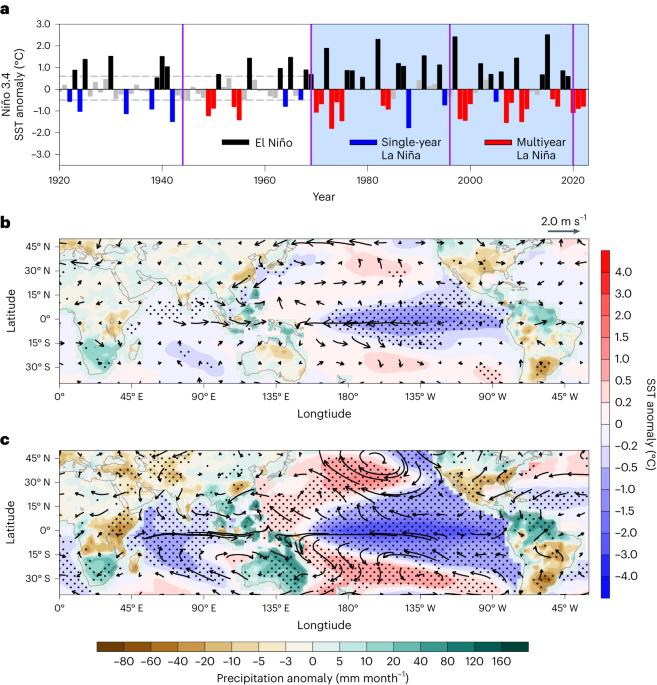了解最近多年期拉尼娜现象增多的原因
IF 29.6
1区 地球科学
Q1 ENVIRONMENTAL SCIENCES
引用次数: 0
摘要
自 1998 年以来,六次拉尼娜现象中有五次持续了两到三年。为什么最近出现了这么多持续时间长的多年期拉尼娜现象,以及这些现象是否会变得更加普遍,目前还不得而知。在这里,我们展示了上个世纪发生的 10 次多年拉尼娜现象的加速趋势,其中 8 次发生在 1970 年之后。这一时期发生的两类多年拉尼娜现象要么是超强厄尔尼诺现象,要么是太平洋中部厄尔尼诺现象。我们发现,多年期拉尼娜事件与单年期拉尼娜事件的不同之处在于其显著的发生率,而这种发生率的根源在于西太平洋变暖增强了太平洋中部多年期拉尼娜事件类型的带状平流反馈,以及超强厄尔尼诺多年期拉尼娜事件类型的热层反馈。大型集合气候模拟的结果支持观测到的多年拉尼娜现象与西太平洋变暖之间的联系。如果西太平洋相对于中太平洋继续变暖,更多的多年拉尼娜事件将加剧对社会经济的不利影响。近几十年来,多年拉尼娜现象越来越频繁。作者在本文中发现,有两种不同类型的多年拉尼娜现象,它们分别与西赤道太平洋变暖的不同机制有关。本文章由计算机程序翻译,如有差异,请以英文原文为准。

Understanding the recent increase in multiyear La Niñas
Five out of six La Niña events since 1998 have lasted two to three years. Why so many long-lasting multiyear La Niña events have emerged recently and whether they will become more common remains unknown. Here we show that ten multiyear La Niña events over the past century had an accelerated trend, with eight of these occurring after 1970. The two types of multiyear La Niña events over this time period followed either a super El Niño or a central Pacific El Niño. We find that multiyear La Niña events differ from single-year La Niñas by a prominent onset rate, which is rooted in the western Pacific warming-enhanced zonal advective feedback for the central Pacific multiyear La Niña events type and thermocline feedback for the super El Niño multiyear La Niña events type. The results from large ensemble climate simulations support the observed multiyear La Niña events–western Pacific warming link. More multiyear La Niña events will exacerbate adverse socioeconomic impacts if the western Pacific continues to warm relative to the central Pacific. Recent decades have seen the increasing frequency of multiyear La Niña events. Here the authors find that there are two different types of multiyear La Niña that are each linked to different mechanisms related to warming in the western equatorial Pacific.
求助全文
通过发布文献求助,成功后即可免费获取论文全文。
去求助
来源期刊

Nature Climate Change
ENVIRONMENTAL SCIENCES-METEOROLOGY & ATMOSPHERIC SCIENCES
CiteScore
40.30
自引率
1.60%
发文量
267
审稿时长
4-8 weeks
期刊介绍:
Nature Climate Change is dedicated to addressing the scientific challenge of understanding Earth's changing climate and its societal implications. As a monthly journal, it publishes significant and cutting-edge research on the nature, causes, and impacts of global climate change, as well as its implications for the economy, policy, and the world at large.
The journal publishes original research spanning the natural and social sciences, synthesizing interdisciplinary research to provide a comprehensive understanding of climate change. It upholds the high standards set by all Nature-branded journals, ensuring top-tier original research through a fair and rigorous review process, broad readership access, high standards of copy editing and production, rapid publication, and independence from academic societies and other vested interests.
Nature Climate Change serves as a platform for discussion among experts, publishing opinion, analysis, and review articles. It also features Research Highlights to highlight important developments in the field and original reporting from renowned science journalists in the form of feature articles.
Topics covered in the journal include adaptation, atmospheric science, ecology, economics, energy, impacts and vulnerability, mitigation, oceanography, policy, sociology, and sustainability, among others.
 求助内容:
求助内容: 应助结果提醒方式:
应助结果提醒方式:


